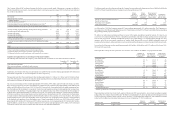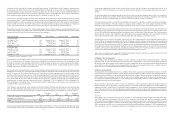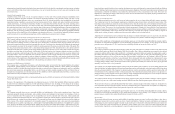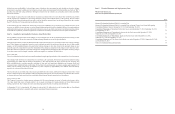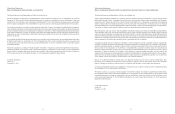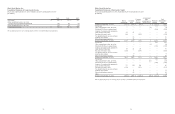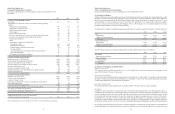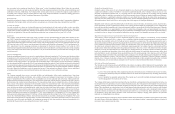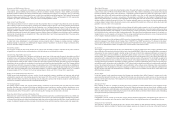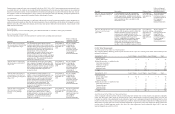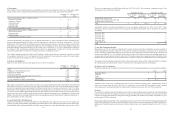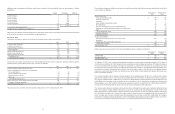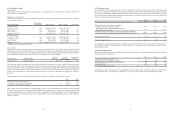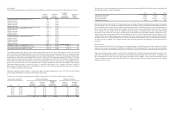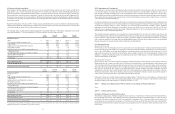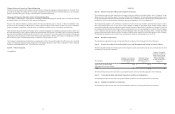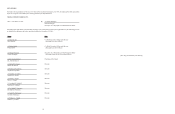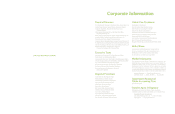Whole Foods 2015 Annual Report Download - page 28
Download and view the complete annual report
Please find page 28 of the 2015 Whole Foods annual report below. You can navigate through the pages in the report by either clicking on the pages listed below, or by using the keyword search tool below to find specific information within the annual report.
43
Foreign currency gains and losses were not material in fiscal year 2015, 2014 or 2013. Intercompany transaction gains and losses
associated with our U.K. operations are excluded from the determination of net income since these transactions are considered
long-term investments in nature. Assets and liabilities are translated at exchange rates in effect at the balance sheet date. Income
and expense accounts are translated at the average exchange rates during the fiscal year. Resulting translation adjustments are
recorded as a separate component of accumulated other comprehensive income.
Use of Estimates
The preparation of financial statements in conformity with generally accepted accounting principles requires management to
make estimates and assumptions that affect the reported amounts of assets and liabilities and disclosure of contingent assets and
liabilities at the date of the financial statements, and revenues and expenses during the period reported. Actual amounts could
differ from those estimates.
Reclassifications
Where appropriate, we have reclassified prior years’ financial statements to conform to current year presentation.
Recent Accounting Pronouncements
The following table provides a brief description of recently issued accounting pronouncements:
Standard Description Effective Date
Effect on financial
statements and other
significant matters
ASU No. 2015-16 Simplifying
the Accounting for Measurement
- Period Adjustments (Topic
805)
The amendments require that an acquirer
recognize adjustments to provisional amounts
identified during the measurement period in the
reporting period in which the adjustments are
determined and eliminates the requirement to
retrospectively revise prior periods.
Additionally, an acquirer should record in the
same period the effects on earnings of any
changes in the provisional accounts, calculated
as if the accounting had been completed at the
acquisition date. The amendments should be
applied on a prospective basis.
First quarter of
fiscal year ending
September 24,
2017
We are currently
evaluating the
impact that the
adoption of these
provisions will have
on the Company’s
consolidated
financial statements.
ASU No. 2015-11 Simplifying
the Measurement of Inventory
(Topic 330)
The amendments, which apply to inventory
that is measured using any method other than
the last-in, first-out (LIFO) or retail inventory
method, require that entities measure inventory
at the lower of cost and net realizable value.
The amendments should be applied on a
prospective basis.
First quarter of
fiscal year ending
September 30,
2018
We are currently
evaluating the
impact that the
adoption of these
provisions will have
on the Company’s
consolidated
financial statements.
ASU No. 2015-05 Customer’s
Accounting for Fees Paid in a
Cloud Computing Arrangement
(Topic 350)
The amendments provide guidance as to
whether a cloud computing arrangement (e.g.,
software as a service, platform as a service,
infrastructure as a service, and other similar
hosting arrangements) includes a software
license and, based on that determination, how
to account for such arrangements. The
amendments may be applied on either a
prospective or retrospective basis and early
adoption is permitted.
First quarter of
fiscal year ending
September 24,
2017
We are currently
evaluating the
impact that the
adoption of these
provisions will have
on the Company’s
consolidated
financial statements.
ASU No. 2015-03 Simplifying
the Presentation of Debt
Issuance Costs (Subtopic
835-30)
The amendments require that debt issuance
costs related to a recognized liability be
presented in the balance sheet as a direct
deduction from the carrying amount of that
debt liability. The amendments should be
applied on a retrospective basis and early
adoption is permitted.
First quarter of
fiscal year ending
September 24,
2017
We do not expect the
adoption of these
provisions to have a
significant impact on
the Company’s
consolidated
financial statements.
44
Standard Description Effective Date
Effect on financial
statements and other
significant matters
ASU No. 2015-02 Amendments
to the Consolidation Analysis
(Topic 810)
The amendments revise the consolidation
analysis related to limited partnerships and
similar legal entities, variable interest entities,
and certain investment funds. The amendments
may be applied on either a modified or full
retrospective basis.
First quarter of
fiscal year ending
September 24,
2017
We do not expect the
adoption of these
provisions to have a
significant impact on
the Company’s
consolidated
financial statements.
ASU No. 2014-09 Revenue from
Contracts with Customers
(Topic 606)
The core principle of the new guidance is that
an entity will recognize revenue to depict the
transfer of promised goods or services to
customers in an amount that reflects the
consideration to which the entity expects to be
entitled in exchange for those goods or
services. Additionally, the guidance requires
disclosures related to the nature, amount,
timing, and uncertainty of revenue that is
recognized. The amendments may be applied
on either a full or modified retrospective basis.
First quarter of
fiscal year ending
September 30,
2018 or fiscal
year ending
September 29,
2019
We are currently
evaluating the
timing, method, and
impact that the
adoption of these
provisions will have
on the Company’s
consolidated
financial statements.
(3) Fair Value Measurements
Assets Measured at Fair Value on a Recurring Basis
The Company held the following financial assets measured at fair value on a recurring basis based on the hierarchy levels
indicated (in millions):
September 27, 2015 Level 1 Inputs Level 2 Inputs Level 3 Inputs Total
Cash equivalents:
Money market fund $ 32 $ — $ — $ 32
Marketable securities - available-for-sale:
Asset-backed securities — 13 — 13
Certificates of deposit — 2 — 2
Corporate bonds — 30 — 30
Municipal bonds — 173 — 173
Total $ 32 $ 218 $ — $ 250
September 28, 2014 Level 1 Inputs Level 2 Inputs Level 3 Inputs Total
Cash equivalents:
Money market fund $ 46 $ — $ — $ 46
Treasury bills 4 — — 4
Commercial paper — 15 — 15
Marketable securities - available-for-sale:
Asset-backed securities — 13 — 13
Commercial paper — 33 — 33
Corporate bonds — 97 — 97
Municipal bonds — 530 — 530
Total $ 50 $ 688 $ — $ 738
Assets Measured at Fair Value on a Nonrecurring Basis
Assets recognized or disclosed at fair value on a nonrecurring basis include items such as property and equipment, intangible
assets, and other assets. These assets are measured at fair value if determined to be impaired. During fiscal year 2015, the
Company recorded fair value adjustments, based on hierarchy input Level 3, totaling approximately $46 million related to certain
locations for which asset value exceeded expected future cash flows, which were primarily included in the “Selling, general and
administrative expenses” line item on the Consolidated Statements of Operations. These asset impairment charges reduced the
carrying value of related long-term assets to fair value. Fair value adjustments, based on hierarchy input Level 3, were not
material during fiscal year 2014 or 2013.


